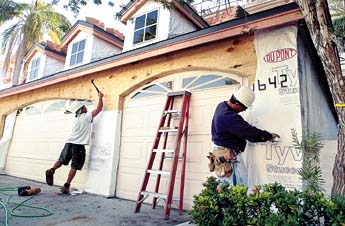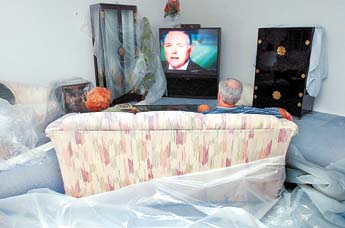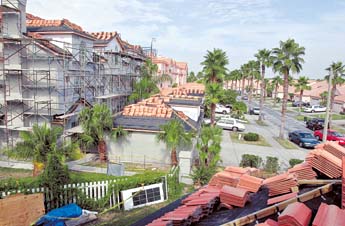| Article and pictures Courtesy of the
St. Petersburg Times
By ROBERT FARLEY Published January 5, 2003
The crowd spilled outside the too-small meeting room at Countryside Country Club. People sat in the aisles and on each other's laps. A stenographer at his side, Bolnick got right to it. Each owner had two weeks to come up with $4,000. Next month, October, each owner would have to pay $3,333. In November, another $3,333. Ditto for December. That made $14,000 by year's end, $24,000 counting the spring. The bruising pace of the special assessments, on top of mortgages and ordinary maintenance dues, exacted a brutal toll. Liens have been placed against 70 homeowners who have not met the payment schedule. Another two are in foreclosure. Some neighbors refinanced, others bailed, selling at distressed prices. Gone are retirement funds and college savings. People are wrestling with sleeplessness, anxiety.
Tuccio took a line of credit for $50,000 but hasn't pulled the trigger on it. If he can't pay a future assessment, why pay this one? "If there's another assessment within a year, I'm dead. Living here is financial suicide, and I don't know what to do." In 1992, neat rows of pink townhouses started rising from what was a cattle ranch. Construction stretched into 1998. Soon after people moved in, they reported leaking water. They complained to the management company, Delis Property Management, and to Nature's Watch developer Richard Geiger and his company, Eagles Reserve. Geiger, who controlled the homeowners association, blamed poor maintenance by Delis, the management company he hired. He said pressure washing blasted caulking off doors and windows. Betty Pantarites, a Delis representative, says that's nonsense. "They didn't knock out the caulking. That's not true. The pressure wasn't great enough. He's just using that as an excuse." Several months after construction was completed in 1998, Geiger dissolved Eagles Reserve. He turned control of the homeowners association over to the residents. The builder, Bama Construction, folded. Most warranties expired after one year. The residents were on the hook for everything. Tired of quick fixes that didn't hold up, the homeowners board hired engineering, architectural and roofing firms to investigate the six oldest buildings. Under the festive pink stucco, they found improperly installed windows, missing flashing, mold and termite damage. Seepage had turned lumber into something like driftwood and reduced plywood to sawdust. The bottom line: major deterioration of the structural framework. To direct the rebuilding, homeowners hired forensic construction expert Art Shand. He called it the worst construction he had seen in his 20 years' experience. Had the developer spent another $5,000 to $10,000 per building for proper waterproofing and flashing, Shand said, "he could have prevented millions of dollars of damage. That's the travesty of this whole thing." Geiger, 63, canceled a scheduled interview for this story. He did not respond to detailed questions put to him in writing. His son, former NBA player Matt Geiger, has no connection to Nature's Watch. People are angry at Geiger -- but also with each other. Nature's Watch is a community divided against itself. The association board decided that all 182 homeowners should share rebuilding costs. But those with no visible damage said they live in homes, not condos, and noted that everyone had to buy homeowners insurance with their mortgage. In neighborhood elections, this faction seized control of the association board and halted construction. Residents of the most damaged buildings filed a lawsuit against the new association board to force it to resume construction and for everyone to pay for it. Retired Pinellas-Pasco Circuit Judge Fred Bryson was assigned the case. What responsibility does a homeowners association have to help individual owners? The Nature's Watch covenants state that the association maintains the exterior of the buildings, including roofs, lawns, driveways and "any other exterior improvements." Bryson ruled that the association must pay for exterior damage. He defined exterior as everything from the interior paint out. The untold millions in repairs would be divided by 182.
They have the room ready, down to the teddy bear at the head of the bed and the baseball cap hanging from a mirror. They managed the $10,000 assessment last spring. They got $2,000 for their 18-foot runabout boat, dipped $3,000 into Doris' retirement savings and scaled back their lifestyle. Then came the $14,000 assessment. "We're just not sitting on that kind of money," Doris, 46, said. They have worked out a payment plan -- $1,000 a month -- but even that has been strain. They used the money they had set aside for the adoption. What if there's another $14,000 assessment in three months? Will they lose their home? A Realtor told them if they sold now, they'd take a bath. Michael, 39, started getting dry heaves. His doctor recommended stress medication for them both. The Leonardos completed their final adoption class Sept. 12, the day after the latest assessment was announced. They've put their plans on hold. "It's called survival for as long as we can right now," Michael said. "How can we bring a child into that? It breaks our heart to know our son is out there in a foster home. Waiting." In May 2000, workers entombed the first six buildings in scaffolding and skinned off the exterior stucco. They replaced improperly installed window units, rotted doors, soggy fiberglass insulation. Out back, they removed rotted wing walls and the balconies they were designed to support. Up top, they pulled up concrete roofing tiles and rebuilt the roof substructure. They uncovered what Shand calls a "pattern and practice" of poor construction. His photographs tell the story: Corners not framed properly, the wood atop the foundations not pressure-treated, dozens of hurricane clips missing along the roofline, the roof pitch so shallow that water could blow back between shingles, caps missing from the privacy wing walls separating the back patios. In one unit, the metal casing of the chimney flue stopped short of the attic. Balconies were built without permits. "Some of the code violations we documented are pretty gross," Shand said. Where were the building inspectors? The county red-tagged some violations during construction, but Shand says they missed far too many. Bryson put it bluntly: "Some building inspector turned his head." Pinellas Building Inspector Robert Nagin said it is unreasonable to expect his staff to catch everything. "Are there code violations? No doubt about it. Are they code violations that we, as a department are responsible for? No. We're not quality control. We're quality assurance." He said some of what Shand found met code at the time. Other problems are not part of a regular inspection, then or now. Some are misunderstandings, not violations, over intricacies of the code. Courts have ruled that county building departments cannot be sued. Typically, it's the building contractor who is taken to task. Under state law, the licensed general contractor who pulls the permits is responsible for overseeing construction. To go after the builder, Bolnick hired Lee Atkinson, a feisty former federal and state prosecutor. The lawsuit Atkinson filed for the residents accuses the developer (Geiger), the builder (Tim Giddens of Bama Construction) and the engineer who drew up the plans (Ralph Hansen) of conspiring to maximize profits by building substandard housing. Through his attorney, Giddens would not comment. Hansen is 93, retired since the mid 1990s. He said he drew up the plans according to code but was too old to supervise construction. "If the construction people didn't do everything the right way," he said, "that's not my fault." The case took an unexpected turn this year when Giddens, under oath, said his Bama construction company had no employees during the time it supposedly was building Nature's Watch. The question followed: If Bama Construction did not build the homes, to whom did it subcontract or delegate the work? The answer: "None." If Giddens was not minding the project, who was? Pantarites, the property manager, said Geiger was in charge. Ed McDermott, a real estate agent who sold units there, said Geiger was "in total control." Gary Tuttle, a project manager for Robertson Electrical Services, said Geiger hired and paid him. Atkinson contends that Giddens, who was a licensed contractor, pulled the construction permits and turned the project over to Geiger. None of the principles of Eagles Reserve, including Geiger, was a licensed contractor during the time Nature's Watch was built. The state is looking into it. Residents say Mark Whitten of the Department of Business and Professional Regulation flew down from Tallahassee in November to meet with them. Whitten said he cannot comment. To keep from having his home auctioned on the courthouse steps, Bill Murray refinanced. He used the $25,000 to pay his assessments, plus $2,500 in legal fees incurred by the foreclosure. He lost six years worth of equity, plus refinancing costs. Then came the second round of assessments. "I felt like Tom Hanks in Money Pit when the bathroom falls through the floor and he just laughs. I can't believe this is happening. It's surreal." Murray, 46, filed a claim under the collapse clause of his homeowners insurance. It was denied. Liberty Mutual said faulty construction was to blame, and its policy excepts damage because of mold, wet or dry rot. In his recurring nightmare, Murray comes home from a business trip to find sheriff's foreclosure signs on his door. The townhouses being rebuilt are down the block and around the corner from Gail Fern's 4-year-old unit. Hers has no visible water damage. From the start, she refused to pay the assessments; she also wouldn't pay a lawyer to make her argument. Her reasoned letter led Bryson to appoint her guardian ad litem for the residents. She says the association has no insurable interest in the damaged homes, so those residents should pay to fix their units. Better still, the county should condemn the homes on the west side of Arabian Lane, let the owners collect their insurance, sell their homes and move on. She was among the first to face foreclosure. In court, Bolnick's attorney cites case law and peppers his argument with Latin legal phrases. Fern, 55, speaks from the heart: Why should she have to pay to fix her neighbors' townhouses? If she loses, her property could be sold at auction. The proceeds would go toward satisfying her unpaid assessments, then to her mortgage holder. She would be last in line. Bolnick says he realizes some owners won't be able to pay the assessments and could lose their homes. He says it's unfortunate but probably inevitable. He says the financial picture is not as bleak as some residents make out. About 20 of the 70 homeowners who got liens are on payment plans. Those who make payments will not face foreclosure. He says others can pay but refuse on principle. Geiger, who lives in Holiday, owns a townhouse in Nature's Watch. He paid the $10,000 assessment in the spring, Bolnick said, but not the $14,000 this fall. Geiger also got a lien. It took $1.8-million to fix the first six buildings, 24 homes. The next six buildings will cost $1.7 million. There are 26 more buildings, each with four units. Bolnick's tack has been to do repairs until the coffers get low, reassess and move on to the next units. He won't hazard a guess how high assessments might go but notes that insurance settlements have averaged about $70,000. "What does that tell you?" His big picture thinking is this: If residents weather the out-of-pocket expense in the short run, they will more than recoup that money when the repairs are completed. Townhouses now selling for $200,000 could fetch more than $360,000. This thinking does not extend to the 32 ranch-style villas on the east side of Arabian Lane. Roughly half the size of the three-story townhouses, villas sold for about $125,000. They are assessed the same as the townhouses. Bolnick says villa values will never increase enough to make up for the assessments. Townhouse residents say they need a final tally so they can decide whether to bail. If they can't make the next assessment, it won't matter how much the place is worth when it's completed. By then, they'll be gone. "Welcome to our life," Susan Jenkins says, gesturing toward the blue tarp covering the bay windows in her dining room. Clear plastic covers the floor and meanders up the stairs. It is in the bedroom, the bathrooms, the living room. Everywhere. For more than three years, Susan and Michael Jenkins have lived with the reconstruction of their three-story townhouse. One day the phones are out. The next, the cable and water are off. Construction gets so loud sometimes they can't hear each other talk. Workers are gutting the interior because their walls contain dangerous levels of mold. "We don't go out," Michael, 49, said. "We haven't bought anything for the house. Everything has been on hold. Knowing now what it's rumored to cost, and what we've lived through the last three years, we would've walked away." Sometimes they fight, Susan, 52, said, with so much stress, how could they not? The fights end when they remind themselves, "We're all we've got." To offset the cost of repairs, Bryson expected the homeowners association would apply settlements people got from their homeowners insurance. But most homeowners have not gotten settlements. Their companies have denied claims based on Bryson's ruling that the association is responsible for the repairs, or that the damage does not meet the terms of its collapse clause, as happened to Murray. Anyway, Bolnick says, the association probably does not have a legal right to such settlements. Expecting only routine maintenance, the association did not get an umbrella insurance policy. To reduce the hit, Bryson recommended the association get a bank loan and stretch payments over a tolerable number of years. But banks have balked, Bolnick said, in part because residents are in court over who should pay for repairs. The warring factions have spent $700,000 in legal fees and it's not over. Harold Berger, a leader of the faction trying to get everybody to pay, says his neighbors still give him the finger. Kelly Kubiak, who owns a vitamin store in East Lake, moved in 11/2 years ago. She became a Home Depot junkie, buying ornate doorknobs for her townhouse as she could afford them, a few at a time. She put stainless steel appliances in the kitchen and figures she spent upward of $14,000 to get everything just the way she wanted. "I put my heart into it." The $10,000 assessment was tough; $14,000 more broke her. She sold to a real estate investor. Between the assessments and what she spent fixing the place up, Kubiak figures she lost about $40,000. "At least I'm young enough I can move on." She is 33. "I'm back living in an apartment, you believe that? And I have a roommate! I left a 2,500 square foot home. It's ridiculous. "I felt like it was ripped away from me. I cried when I left." Real estate investor Kevin J. Geigle and his brother bought Kubiak's townhouse. They bought two others and have two more deals in the works. Geigle said he got the units so cheap that if future assessments don't go higher than $20,000, he'll end up well ahead. "This is kind of a risk-taking thing," he said. "I'm rolling the dice and taking a chance." In a break usually associated with sinkholes and other natural disasters, last year the property appraiser's office knocked $30,000 off the appraised value of every home in Nature's Watch. About a dozen homeowners appealed and their values were slashed more. The county attorney is exploring an application for state disaster designation. State Rep. Gus Bilirakis, R-Palm Harbor, and his father, U.S. Rep. Mike Bilirakis, R-Tarpon Springs, have tried to mediate a settlement to the lawsuit that pits neighbor against neighbor. In October, residents who want a greater voice organized a group they call the Silent Majority. They want to hire a professional project manager to oversee reconstruction and make sure they're not being gouged. They want to explore long-term, low-interest loan options. Last month, they convinced Bolnick to conduct test borings in buildings throughout the community so they can better predict how much repairs will cost. Chuck Badgley, one of Silent Majority's leaders, says the most important message is to Bryson. People can't come up with $3,333, month after month, on top of their other bills. The cost -- in heartache, devastated lives, homes lost -- is too high. "Let's stop the process, the liens and foreclosures," Badgley said. "Let's declare a moratorium until we come up with a long-term plan. You're moving too fast, faster than the community can keep up with you." This week, workers began to dismantle scaffolding from some of the just-completed buildings. Next they will make test cuts into townhouses on Lago Vista Boulevard. |



